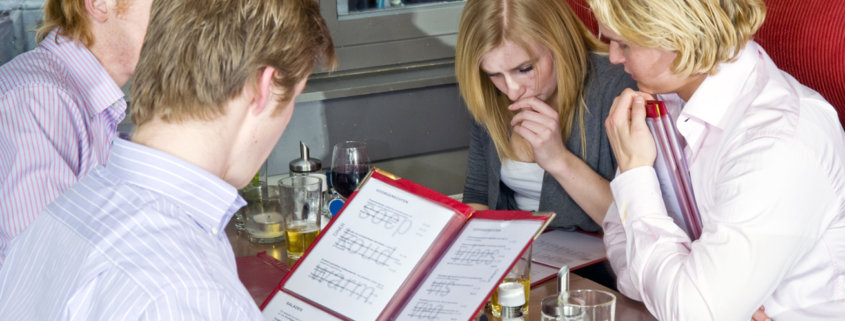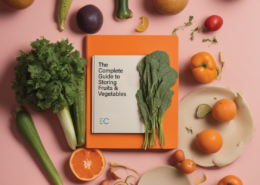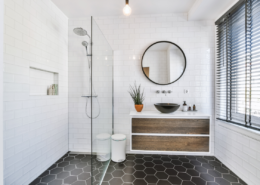The Ultimate Restaurant Menu Cheat Sheet
A restaurant menu—no big deal, right? It’s just a list of the food items a restaurant offers its customers. Sure it is. Plus a whole lot more.
Before restaurant menus ever make it to print, restaurant owners hire menu engineers and consultants to bury super sneaky psychological tricks into the pretty pictures and mouth-watering descriptions for one reason: to get you to spend more money.
Want to beat restaurants at their own game? Here’s your cheat sheet listing the sneakiest of sneaky tricks.
Dollar signs
Sophisticated research tells restaurants to stop including dollar signs on their menus because a dollar sign—or even the word “dollar” spelled out instead—triggers negative feelings associated with paying. Both the sign and the word remind customers that they’re spending money. (Well, imagine that!)
Number choices
Menu designers work under a strict list of rules, one of which has to do with the number 9. Consumers have been taught to believe that prices that end with 9, such as $7.99, offer value but not necessarily quality. And get this, prices that end in .95 instead of .99 are more effective, meaning subconsciously, customers are more likely to choose them because the price appears to be friendlier.
Flowery language
Further research has revealed to restauranteurs that beautifully written descriptions of food choices appeal to unsuspecting customers. And that descriptive menu labels, in one impressive study, increased sales by 27%, as compared to food items without fabulously written descriptions.
Here’s an example offered by menu engineer Greg Rapp, when he appeared on NBC Today Show. Instead of the menu listing simply “Crab Cakes,” naming them Maryland Style Crab Cakes that are made by hand, with sweet jumbo crab meat, a touch of mayonnaise, our secret blend of seasonings, and golden cracker crumbs for a rich, tender crab cake, a customer cannot help but have some kind of sensory experience just reading the description.
That kind of flowery language gives customers satisfaction that prompts them to just go for it, without much thought for what it will cost. The anticipation is nearly unbearable if you’re hungry—”I need Maryland Style Crab Cakes!”
But wait. There’s more. If the menu description includes a brand name or two, like Jack Daniel’s sauce or Duke’s Mayonnaise—sales are set to increase like magic.
Nostalgic family connections
Oh, this is really sneaky! Research assures menu makers that sales soar when they can pull in the thought of a beloved family member, Bam!. Recognize the trick when you see Grandma’s Famous Meatloaf on a menu or Aunt Millie’s Apple Cobbler.
Not only has that been designed to assure you of a perfect food experience, but it also makes you nostalgic. If you’re not paying attention, those feelings can be overwhelming to the point of jacking up the final tab to a whole lot more than you ever planned to spend.
Authenticity assured
This is very common in ethnic restaurants. Instead of an Italian restaurant offering lasagna for example, if the name is expanded to include a region or area of Italy, we assume a better outcome. Hey, it’s Authentic Lasagna from Northern Italy, which of course makes it worth at least a few more bucks.
Bring on the fonts
When menu items are bolded, printed in a different color or enhanced with images, fancy fonts, photos, or—the big one— isolated in a separate box, they look like they’re a lot more special than the other cheeky items that are part of a boring list on the other side of the menu.
If the All-Star Perfect All-Beef Burger gets its own box and print color, it’s got to be well worth the $12.95 price. Ha! That’s what they’re working so hard to convince you.
Food decoys
No kidding, that’s what the experts call them—decoys to manipulate you into doing their bidding. Here’s how it works:
You sit down, open the menu and lock eyeballs with the $11.95 Patty Melt, sans description. Just a Patty Melt for twelve bucks. You scoff. Ha! Not me. Then your eyes wander over to the boxed item with a photo of the world’s most perfect burger (titled accordingly) that makes you salivate. And it’s $16.95 complete with French Fries and Jack Daniel’s Dipping Sauce.
No way! You know what they’re doing here. You make your decision. It’ll be the Patty Melt, no fries no sauce. And aren’t you clever?
Not so fast, buckaroo. You just played into their hands and they’re laughing all the way to the bank! That burger that no one ever orders is a decoy. Priced at $17, it’s so ridiculous, customers laugh silently and then have no problem at all with a $12 Patty Melt.
- MORE: Never Trust a Dark Restaurant
Size choice
When the menu gives you a choice of two sizes with two corresponding prices—let’s say Large or Medium Salad—you’re being primed to go for the smaller size to save money, or so you think.
Truth be told, the restaurant wanted to sell you the smaller portion at the lower price with its not-so-small-price all along and simply used the larger option with a much bigger price to give you a comparison—and to seal the deal for them.
Reading patterns
They’re called scanpaths, and they’re the way most people fix their eyes and the path they take while reading. Menu engineering takes full advantage of the way they know we see things.
Statistically, they know we will order the first item to which our eyes are drawn upon opening the menu. We might read the whole thing, but it’s that number one that is so important to the restaurant’s bottom line.
This is the reason restaurants put the most profitable items in the upper-right corner. That is where customers’ eyes go first. Beyond that, they know that we are most likely to better remember items at the beginning of a list. So if we lay eyes on a list first thing, it’s the first thing in that list that we are most likely to order. And guess what they choose to put in that spot? You got it!
Limited choices
Restaurants are learning they need to limit choices because of the heavy responsibility people feel when choosing what to eat. (Say, what?) The optimum number of menu items is six per category in fast-food restaurants, and seven to 10 per category in fine dining places.
For this reason, restaurants are going to more mindless options that won’t require a customer to make a specific choice—“try alls,” like samplers, tapas or fixed menus where the chef decides.
- MORE: Never Trust a Dark Restaurant
Lovely ambiance
The wall colors, choice of finishes, furniture style, music, impeccable taste throughout—all of the things that set the ambiance are there for one reason: to make us willing to spend more. Playing classical music sets us up to accept higher prices. And they know that playing less sophisticated music causes people to spend less.
And in conclusion…
There you go—your restaurant menu cheat sheet with all the tricks you need to know to beat restaurants at their own game;
As you notice these tricks, concentrate on them momentarily. Then determine to go rogue by making up your own mind without feeling manipulated into buying a pricey patty melt or crab cakes, uh … I mean the delectable Maryland Style Crab Cakes.















Since the quarantine ended, Covid shots available,, restaurants open it was out to dinner for us again. It’s not been a good thing. The quality of food is down, prices up, my favorites (I’m the picky one), I’m back to cooking at home. We’ve had hair in our food, grossly overcooked steaks, dried out ribs and weird tasting food that made us ill. That was the finish for me. Ugh
Hi Mary,
So, when the restaurant offers the medium and large priced salad…sounds like they get you both ways. What’s the best choice as a rule?
Thank you! This post was fabulous.
Gina
I don’t think there’s an answer for that … the point is to be aware so you can make a good decision. Does the larger size have more of what you really want and will finish? Is it that much different than the medium?
It makes me so furious that no restaurants put the price of soda, tea or coffee in the menu anymore. And when I dare ask the waitress the price she always looks rather shocked and says she doesn’t really know.
This made me think about creating a home ‘menu’ not with all the bells and whistles but just sort of a list to remind me of dishes I can make but may not think of making or buying the ingredients for. Anyone do that?
Hi Marilyn,
I do keep a list of EASY to fix meals when i don’t want to cook that remind me of my choices. I also make up family sized meals (and there’s just two of us) and freeze meal-sized portions that i can microwave easily…no work!! I love to cook…but not every night. LOL.
BEST FOODS REAL MAYONNAISE brand is also Hellmans Mayo. Is family restaurant & fine dining, 6 times the cost of prepping same food at home. Plus beverage markups
Personally I like the full descriptions because they make it easier to estimate the amount of carb in a meal, and therefore how much insulin I need. And in the final paragraph, I think you meant to say we should go rogue, not rouge.
And yes I did! Thanks for being such a good mind reader. i do iike rosy cheeks, however ☺️.
“Hellman’s mayonnaise—sales are set to increase like magic.” Ew. No. Duke’s Mayo might catch my attention but Hellman’s mayo would be an immediate turn off.”
Good catch! I live in the West where we have … neither!! (I feel an edit coming on … )
Ohhh, but I LOVE Hellman’s! 🙂
Aldi’s Burman brand mayo is just as good as Hellman’s and half the price! Try it, you’ll like it. We used Hellman’s for years until we discovered Burman’s.
Oh Cathy!! I grew up in the suburbs of Philadelphia and that is all we ued right up to 2 years ago! I bought a small jar of Duke’s at Walmart just to see what it tastes like and much cheaper than Hellman’s I found that it tastes great and helps me with the cost! I really do love Hellman’s but since I retired, I have to watch my spending.
I grew up in the Philadelphia suburbs and then the Jersey Shore (Long Beach Island) and always used Hellman’s, but about 4 years ago I decided to try Duke’s. I bought the little jar in case I did not like it, but I really liked it and it was half the price of Hellman’s. Who knew? I am retired and have to watch my $$ and thanks to Mary I have learned so much from her since 1998!!
The older I get, the more annoyed I become with restaurants that think they are being fancy if they hand you a menu the size of Texas with miniscule fancy fonts.
Or how about when they hand you a menu that is so fresh and new you can nearly smell the fresh ink? Always a tip off of price increases.
Great info as usual !! I would never have imagined that so much work goes into a menu! Thanks for opening our eyes!
Thank you, Gretchen for your kind words! You’ll never look at the menu the same way again!
I must admit to really not wanting to eat at restaurants at all simply because they make it so uncomfortable to eat at their tables.I am 5’4″ , not at all tall, and I have not yet found a restaurant where the table is not almost chest high when I am seated. Chair or bench makes no difference. I would rather just take the meal “to go” and eat at home in comfort.